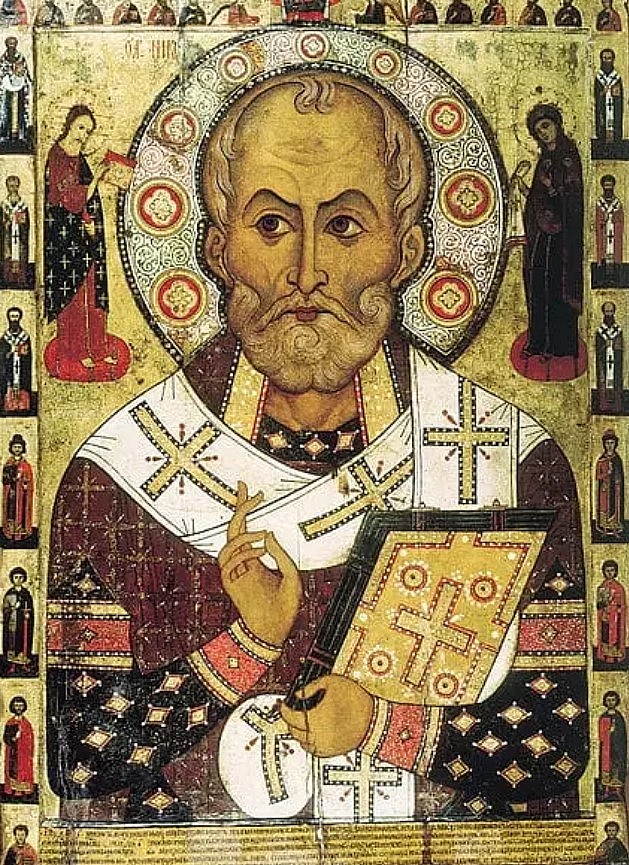Who is Santa Claus: Real Name and St. Nicholas Biography
♦ How To Write, Send Letters To Santa Claus and Get Wanted Gifts
Who is Santa Claus?
Santa Claus is a fictional character who delivers presents to well-behaved children on Christmas Eve. The legend of Santa Claus has its origins in Western Christian culture, and is largely based on the historic figure of Saint Nicholas, a real-life Greek bishop who lived during the 4th century and was known for secretly leaving gifts at the homes of children.
According to folklore, Santa Claus lives at the North Pole, where he keeps a list of the names of all the children in the world, marking them as ‘naughty’ or ‘nice’ depending on their behaviour throughout the year. He brings presents to the homes of good children on Christmas Eve with the help of his elves and the magic flying reindeer who pull his sleigh.
Top 15 Weirdest Christmas Traditions around the World
Who is St. Nicholas: The Real Santa Claus, The Origin of Santa Claus
Saint Nicholas was a Christian bishop who always helped the poor and the sick. After his death, the myth of his gift giving grew in popularity. Saint Nicholas gradually transforms into a legendary character named Santa Claus, who brings Christmas gifts to children around the world.
 |
| The name Santa Claus is the English form of the Dutch name for St. Nicholas Sinterklaas. |
Childhood of St. Nicholas
Saint Nicholas was born around 280 in Patara, Lycia, in what is now Turkey. He lost both his parents at a very young age, so he decided to use his inheritance to help the poor and the sick. A devout Christian, he became bishop of Myra, now the city of Demre.
Reputation of St. Nicholas
There are many legends about Saint Nicholas of Myra. One of those legends is a story about how he helped the family of three poor sisters. The father of three sisters did not have enough money to buy dowries for his three daughters, so he had to sell them as slaves. For three nights in a row, Saint Nicholas secretly went to the father and son's house and put a bag of money inside the house. The man used the money to buy dowries for his three daughters to get married. On the third visit, the father found out about it, so he thanked the saint for helping his family. In addition, Saint Nicholas also rescued three men sentenced to death from prison.
St. Nicholas's Death and Legacy
Some accounts believe that Saint Nicholas died on December 6, 343. Over the years, stories of his miracles and helping the poor spread around the world. He is considered the guardian of children, sailors and gift giving. He was a popular saint in Europe until the Protestant movement in the 1500s led to the birth of Protestantism, which refused to practice rituals honoring saints. However, Saint Nicholas remains an important figure in the Netherlands.
The Dutch continue to celebrate the feast of Saint Nicholas, on December 6 every year. During the holidays, children often take off their shoes the night before. The next morning, the children will receive the gifts that St. Nicholas left in their shoes. Dutch immigrants brought the legend of Saint Nicholas, known as Sint Nikolaas or his nickname - Sinterklaas, to America in the 1700s.
The legend of Saint Nicholas undergoes many transformations in America: Sinterklaas becomes Santa Claus and instead of giving gifts on December 6, he becomes part of the Christmas holiday. In the poem "An Account of a Visit from Saint Nicholas" written in 1820 by poet Clement Clarke Moore, he is described as a chubby, funny man who climbs down a chimney to give presents to children. worthy child and drive a sleigh pulled by reindeer. Artist Thomas Nast added a twist to the legend of Saint Nicholas with a drawing of Santa Claus wearing a red suit with white fur trim. Once a kind, benevolent bishop, Saint Nicholas is now the Santa Claus we know today.
10 Facts about Santa Claus
1. Until the 16th century, Santa Claus and Father Christmas were not synonymous.
2. Santa Claus had his origins in tales of St Nicholas, popular among the Dutch who referred to him as “Sinter Klaas”.
3. Father Christmas had his origins in medieval stories who gave presents at Christmas time.
4. The Dutch still celebrate St Nicholas with their Christmas present-giving on December 6, which is St Nicholas’s feast day.
5. The earliest known use of the name Santa Claus in English was in 1773 in America, as reported by Express Uk.
|
|
| Santa Claus. Photo: Express.uk |
6. The Charles W Howard Santa School, Michigan is the world’s oldest Santa school. It began in 1937.
7. In 2013, Nelson Mandela became the first person to be named Santa Claus of the Year by the prime minister of Greenland.
8. The earliest depictions of Santa Claus have him wearing a green cloak.
9. His modern image, with flying reindeer and entry down chimneys, began with Clement Clarke Moore’s poem A Visit From St Nicholas in 1823.
10. His red cloak only became established in 1931 through a Coca-Cola advertising campaign.
Definition of Santa Claus
Santa Claus is an imaginary man with a long white beard and a red suit who brings presents for children at Christmas
Meaning of Santa Claus
The term Santa Claus comes from the Dutch ‘Sinterklaas’ meaning ‘Saint Nicholas’ and was first used in American English around 1765.
Quotations of Santa Claus
“I stopped believing in Santa Claus when I was six. Mother took me to see him in a department store and he asked for my autograph.” - (Shirley Temple Black)
 Top 10 Most Delightful Christmas Markets To Visit In Canada Top 10 Most Delightful Christmas Markets To Visit In Canada How is Christmas atmosphere in Canada? It can be felt through how busy the Christmas markets are. Let’s find out what Christmas markets are the ... |
 Top 10 Best Christmas Markets To Visit In The UK Top 10 Best Christmas Markets To Visit In The UK Christmas is coming to town. If you live in the UK, get ready for a festive season with full of mas markets everywhere. |
 Christmas Eve: History, Meaning and Celebrations Christmas Eve: History, Meaning and Celebrations Christmas Day is coming to town. Have you figured out what you would do on Christmas Eve? But first, let's take a look at Christmas ... |



























